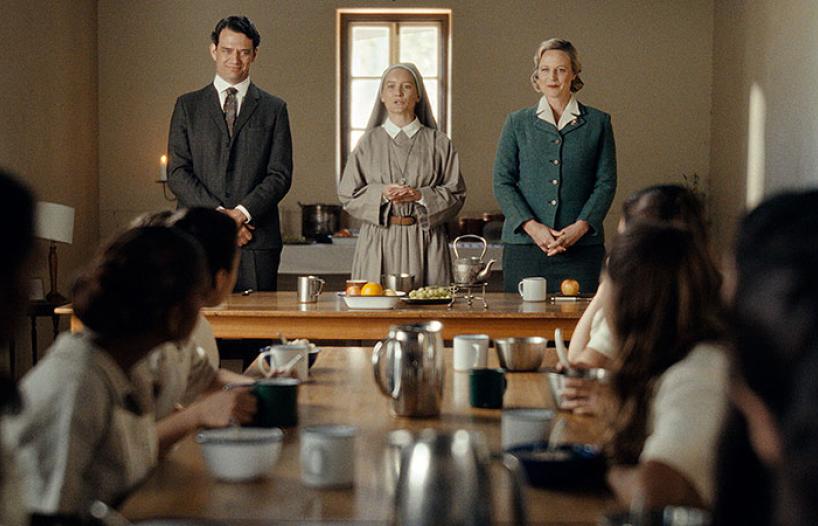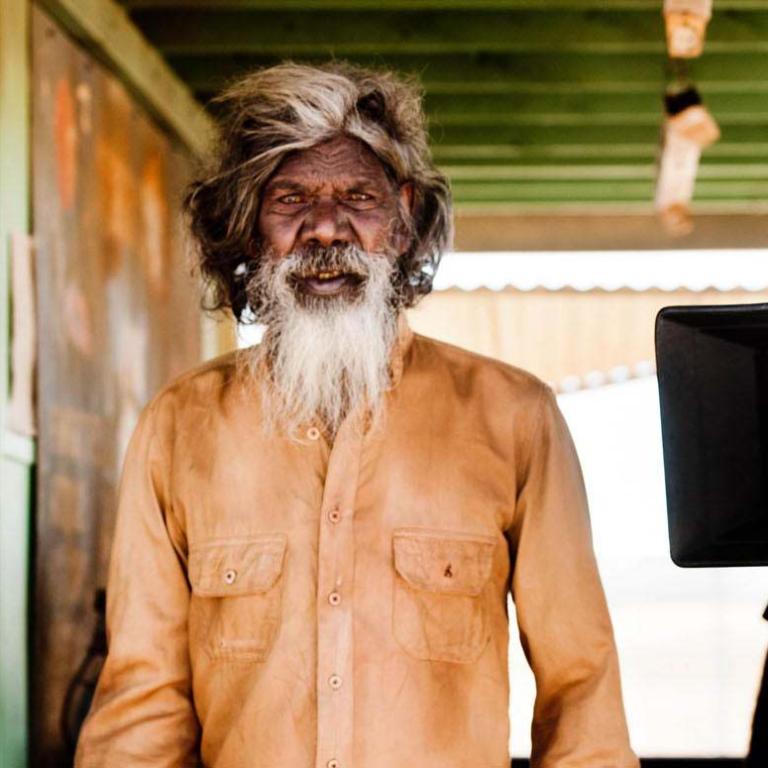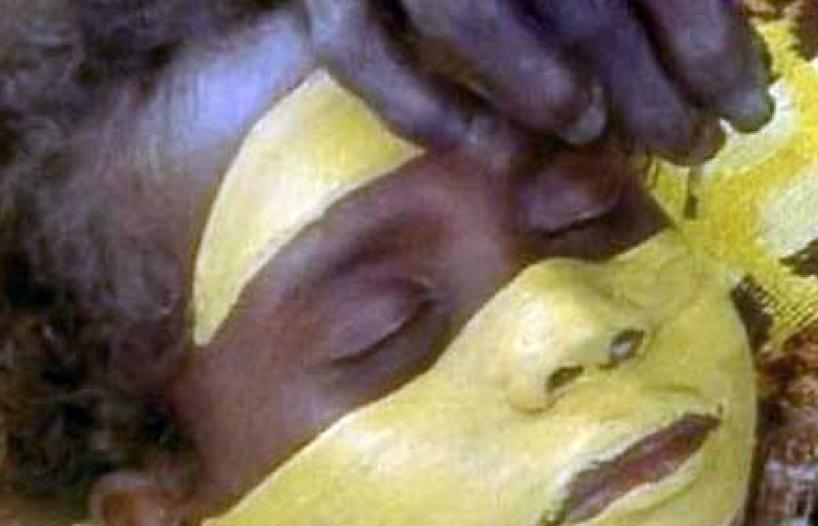
Warning: this page contains names, images and voices of deceased Aboriginal and Torres Strait Islander people.
Strength, vision and legacy

At just 13, Quaden Bayles has already made his mark on the big screen. In 2024, he joined one of cinema’s most iconic universes, appearing as a War Boy in Furiosa: A Mad Max Saga, amidst one of the film’s most spectacular set pieces.
It was Quaden’s second collaboration with director George Miller, following his debut in Three Thousand Years of Longing (2022). These roles have cemented his place as a young actor with serious screen presence – part of a new generation reshaping what Australian cinema can be.
Quaden has spoken with pride about his connection to Redfern, drawing strength from his community and from a family legacy that includes broadcaster and activist Tiga Bayles. His story has also been explored in Living Black and Australian Story, tracing a creative journey still unfolding: one grounded in culture, resilience and a deepening body of work.

Actor, writer, producer – Miranda Tapsell (Larrakia) does it all. Her audiences know her from her big screen appearances – most notably Top End Wedding, The Sapphires and The Dry. But did you know you can also hear her in the Logie award-winning animated TV series Little J & Big Cuz, and international juggernaut Bluey?

The NFSA interviewed Hunter Page-Lochard, the star of Spear (2015), about making the film and the importance of dance in First Nations culture. The interview also explores how Page-Lochard felt about working closely with his father, Spear director Stephen Page, the advantages of growing up on the stage and what he looks forward to in the future.

In 2022, director Jub Clerc (NyulNyul/Yawuru) delivered her debut feature film Sweet As to our screens. It's a touching coming-of-age film that’s as much about Country where it was filmed as the people who are in it.
Nakkiah Lui: Kiki and Kitty
Actor, writer and comedian Nakkiah Lui has emerged as a creative tour-de-force, with credits to her name that include Total Control, Black Comedy and Kiki and Kitty, which she wrote and starred in (as Kiki, opposite Elaine Crombie). It follows the adventures of a young, black woman in a big, white world, who comes into her own when she starts listening to herself. As Kiki grows more self-confident, she blossoms and moves away from the awkward, second guessing do-gooder the audience meets at the start of the series.

Indie-roots musician Thelma Plum features among our Black and Deadly Women in Music. She was in the first intake of students to graduate from Brisbane’s Music Industry College and was soon discovered on Unearthed by Triple J with her song Father Said. Her debut EP, Rosie, earned her the NIMA for New Talent of the Year.
The storytellers

Finding Jedda
Winner of Best Short Film at the 2022 AACTA Awards, Finding Jedda is writer/director Tanith Glynn-Maloney's ode to Jedda (1955), the first Australian film to feature First Nations actors in the leading roles. More specifically, it’s a tribute to the star of the film, Rosalie Kunoth-Monks.

Katele (Mudskipper)
Katele (Mudskipper), from director John Harvey, won Best Australian Short Film at Flickerfest and MIFF in 2023. The film tells the story of the worn-down Martha (Elma Kris),whose thankless job at a laundromat goes from mundane to extraordinary when she is offered a glimpse into another life by an unexpected visitor.

Shiny One
Youngfella Wenye (Kurt Abbott) can’t catch a break. But while many people have vision boards to manifest a life of luxury, Wenye literally dreams of finding gold – not just so that he can buy a nice Toyota, but so that he can procure some grub. He’s hungry and tired of not having enough.

Kindred
Kindred (2023) is a deeply personal feature-length documentary that delves into the emotional landscape of family, love and loss through the eyes of two close friends, filmmakers Adrian Russell Wills and Gillian Moody, who first met while making the short film Angel, and realised they’d grown up only streets apart.
The trailblazers
In these portraits, prominent First Nations Australians talk about their lives.
Interview subjects include filmmakers Wayne Blair and Rachel Perkins (seen here talking about her 1988 debut feature Radiance), alongside profiles of sporting stars like Mark Ella, Nova Peris and Anthony Mundine, and artists Albert Namatjira, Mervyn Bishop and Tracey Moffatt.
You can see the full interview with Rachel Perkins also watch Australian Biography interviews with Charles Perkins, Faith Bandler, Lowitja O'Donoghue and more.
Blood Brothers – Freedom Ride (1993), directed by Rachel Perkins, is a documentary chronicling the 1965 'freedom ride' led by her father, Dr 'Kumantjayi' (Charlie) Perkins AO. During this pivotal event, Dr Perkins and fellow University of Sydney students travelled through rural NSW to expose racial segregation in Australia.
Eddie Koiki Mabo (1936–1992) was a Meriam man from the island of Mer (Murray Island) in the Torres Strait. His name has become synonymous with Aboriginal and Torres Strait Islander land rights because he was a key plantiff in the Mabo case.
Her voice has graced our ears for decades, and her compositions and operas are genre-defining gems that enrich all who experience them. Perhaps most significant is Australia’s first Indigenous opera Pecan Summer, written and composed by Deborah.
Listen to Dali Mana Gamarada and read more about Deborah Cheetham

David Gulpilil AM (1953–2021), forever changed the way Australian film represents Indigenous people and their cultural heritage.
A Yolngu man from Arnhem Land in the Northern Territory, he was a dancer, actor, singer, painter and storyteller. His first acting role – in Nicolas Roeg's Walkabout (1971) – began a career that spanned over 50 years.

Archie Roach and Ruby Hunter were partners in life and music for more than 35 years before Ruby's death in 2010. This collection explores the collaboration between Ruby and Archie and includes rare footage, live recordings, photographs and home movies.

From Evonne Goolagong to Cathy Freeman, we shine a light on triumphant moments in sport by First Nations athletes.
The dreamers
A short history of First Nations filmmaking
In a relatively short space of time, Australian cinema has evolved from depicting Aboriginal and Torres Strait Islander peoples through racist clichés to First Nations creatives documenting their cultures, promoting social change and making entertainment, entering the mainstream. This shift is exemplified by critical and box-office hits from directors like Rachel Perkins, Warwick Thornton and Wayne Blair, which deal with complex issues and feature First Nations actors and characters.
This reshaping of a cultural landscape and determined shift for Australian cinema’s national identity came about through a gradual reframing of First Nations rights within the Australian legal system, combined with government support for the development of Aboriginal and Torres Strait Islander filmmakers.
In the article A Short History of First Nations Filmmaking in Australia we explore the compelling arc of First Nations storytelling on film in this country, from early representations through a white lens to collaborations between non-Indigenous and Indigenous filmmakers, and a breakthrough generation of First Nations filmmakers telling their own stories.
We spoke with Warwick Thornton about his film The Darkside (2013) – an anthology of first-hand Indigenous ghost stories. The Darkside includes a sequence set at the NFSA in Canberra which explores the history of the building as the former Australian Institute of Anatomy where First Nations remains were kept and studied.
In 2022, the NFSA screened the documentary Ablaze (2021) and hosted a Q&A with co-directors Tiriki Onus and Alec Morgan. Ablaze tells the story of Bill Onus, a Yorta Yorta/Wiradjuri man from Victoria and Australia’s first Aboriginal filmmaker. He revived his people’s culture in the 1940s and ignited a civil rights movement that would, against enormous odds, change the course of history.
The NFSA celebrates Deborah Mailman in this online collection covering her stellar screen career. As well as being one of Australia's favourite actors, Deborah Mailman is also an important figure in First Nations filmmaking and storytelling. Her work has been part of a movement that has reframed the way First Nations performers are cast and portrayed in mainstream productions and helped empower Indigenous artists to tell their own stories.
Deadly sounds

First Nations Sounds of Australia features the voices of First Nations artists who have been inducted into the NFSA's Sounds of Australia registry. They include the best-selling Aboriginal music album in history, the first mainstream chart hit for an Aboriginal artist, a poetry reading by Oodgeroo Noonuccal and Tasmanian Aboriginal songs and languages recorded in the 1890s.
Also represented are popular artists like Christine Anu, Archie Roach, Kev Carmody, No Fixed Address, Yothu Yindi and the Warumpi Band.

This was the first recording by an Indigenous Australian to achieve mainstream chart success, reaching No. 1 on the Sydney charts and No. 10 nationally. The song established Jimmy Little as a star in Australian popular music and his career continued for over 40 years.

This collection celebrates the black and deadly women of Australian music, from Fanny Smith in the 1890s to Jessica Mauboy in the 21st century, and hits an array of genres including country, jazz, pop, folk and rock.

Following in the footsteps of her aunt Georgia Lee, Wilma Reading’s jazz ambition took her around the world. Throughout her 40-year career Wilma performed with some of the world’s leading jazz musicians, including the legendary Duke Ellington Band. She also appeared on America's most iconic TV talk show, The Johnny Carson Show.
Yothu Yindi's 'Treaty': On 14 July 1991, a remix of Yothu Yindi’s ‘Treaty’ became the first song by an Aboriginal band to reach the mainstream pop singles chart in Australia, peaking at No. 11 in September 1991. Yothu Yindi collaborated with Paul Kelly and Peter Garrett in writing ‘Treaty’, which was included on the band’s second album, Tribal Voice (released October 1991). The song was a powerful protest against the lack of a treaty with Australia’s Aboriginal and Torres Strait Islander peoples. Read the story behind the 1991 remix of 'Treaty'.

This iconic Australian protest song pays tribute to the Gurindji people. Written by prominent Australian singer-songwriters Paul Kelly and Kev Carmody, the lyrics tell the story of the Wave Hill Walk-Off in 1966 – an event which become a catalyst for the Aboriginal land rights movement.


Celebrated choreographer Stephen Page's first feature film, Spear (2015), explores themes of dislocation and identity.
We meet Djali (played by the director’s son and Cleverman star, Hunter Page-Lochard), a young First Nations man on a confronting journey, shadowed by Suicide Man (Aaron Pedersen).
The film is a story told through dance, adapted from work by Bangarra Dance Theatre. It is beautifully scored by Page’s brother David Page, and stunningly shot by Bonnie Elliott.
Watch the trailer for Spear or read an interview with Hunter Page-Lochard.

Douglas Watkin’s documentary Ella is about the Australian Ballet's first Indigenous dancer, Ella Havelka, and the challenges she faced in making the transition from Bangarra Dance Company to performing traditional Western-style ballet. Listen to this Q&A with Ella Havelka and Douglas Watkins from 2019.

A celebration of Indigenous song and dance, from the traditional to the contemporary, the award-winning Carriberrie website offers a 360° experience set across stunning Australian landscapes. It features 156 dancers, 23 performances and 9 cultural groups.
Ceremony, art and culture

Djungguwan Ceremony
The Djungguwan Ceremony is performed by the Yolngu people of north-east Arnhem Land. This collection gives an insight into three different ceremonies, from 1966, 1976 and 2002.
The aim of the Djungguwan is to bring young boys into the Law, identifying them with clansmen of previous generations and with their ancestral origins.
Through song, dance and art, the ceremony tells a narrative about two ancestral beings, the Wawilak Sisters, as they journey through Country creating each tribe and clan and giving them their Law. No two performances of the Djungguwan are the same.

First Nations artists and art
The NFSA holds a vast array of films documenting First Nations artists and art. This collection illustrates the many and varied ways that First Nations Australians express themselves through art.
The collection also shows how Aboriginal and Torres Straight Islander peoples have worked together to form artist collectives and cooperatives to the benefit of their communities.
It features a range of characters and art styles and reminds us of the importance of the Dreamtime, spirituality and the strict rules that govern who can tell certain stories in Aboriginal cultures.
The National Film and Sound Archive of Australia acknowledges Australia’s Aboriginal and Torres Strait Islander peoples as the Traditional Custodians of the land on which we work and live and gives respect to their Elders both past and present.







